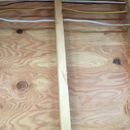Running coax and phone line parallel with electric wire?
Hi folks,
Without much prior experience, I decided to run my coax and phone line myself but after the fact, I have read that it’s not good to run the phone/coax parallel with electric wire?.
As you can see in the picture, I have the coax/phone lines ran a couple inches above 12g and 10g wire. This goes for about 20 ft.
My question is – how much space in between the coax/phone and electric wire is needed to allow parallel runs?
I surely have to have a parallel run at some point. The best I can do is drill new holes towards the bottom of the wall, which would give me about 5 ft space in between the two runs.
Is my current setup ok? Should I give them more like 5 feet? Or will neither be sufficient.
I realize this isn’t really a construction question but perhaps someone on here has experience.
I do not want any interference with my cable/ wifi so this is quite important to me.
GBA Detail Library
A collection of one thousand construction details organized by climate and house part










Replies
Hey Michael,
Thanks for weighing in.
In that case, I will definitely move the run. So do you think if I run the coax/phone parallel, but 5ft below I will be ok?
Is it recommended to have a few vertical/90 degree bends to break up the parallel path?
Tom, the calculations are a bit beyond me, but I'm sure 5' is way more than enough. 1-2' is probably all you need, but the more, the better. I don't think you'll need to create any right angles. Best practice, as I learned it, is that it's fine to cross low-voltage and line-voltage at right angles, though.
Tom, I don't believe there is a code for this, but in practice 6-12" is what I've seen recommended. It depends on how many amps the NM cable is carrying, how long and how parallel the lines are, how constant the current is, and how sensitive the equipment the low-voltage lines are connecting to. The coax is better protected than the phone line due to the way it's wrapped. The main concern is the induced current in the NM cable causing interference in the low-voltage line. 10ga cable can carry up to 30 amps, 12ga up to 20 amps, so you have up to 50 amps creating an electrical field around the cable.
IMO. I would pull out the coax and replace it with conduit then pull separate or perhaps bundled cable distributed to a couple of primary rooms in the house. Use Quad Shielded RG6 coaxial cable and Cat6 all wired to a central hub.
Wireless will be the future coupled with 1 Gbps service to the home via fiber optics or enhanced cable. I have 1Gbps now via ATT Fiber.
Conduit will allow you or a future homeowner to pull upgraded cable although I can't think of many items within a house which in total are going to require more than 1Gbps of bandwidth.
You should be OK with a minimum of 2" separation. It's better to have more, though I personally wouldn't re-pull the wire unless you're approaching the 100m max run length for Cat5/6. (In which case, ouch... that's a lot of work!) I'm sure you've searched the web and found that there isn't a simple answer in terms of code requirements. Part of that is because the electrical code is mostly concerned with safety. For example, you don't want a stray nail to puncture NM and put line voltage on your Cat5/6 wire. The ~2" minimum is probably intended to address that sort of case. The telecom specs are more concerned with interference and call out fluorescent fixtures as well as line voltage wiring and call for more separation.
I managed a university network infrastructure team and came across all sorts of screwball low-voltage cable routing. I don't remember any Cat5e runs that didn't test out OK at 1 Gbps once termination problems and/or wire damage had been ruled out. I don't have similar experience with coax, though it's probably less susceptible than Cat5/6 because it's shielded.
Tom,
Think how you will be using the phone and internet portion of your infrastructure. If you are like most people, you will be talking and connecting mostly over wireless devices. I have Cat 5 and wifi in my house and really can't tell any difference in connection speed or quality. I prefer using a POT for my business and personal calls, but that is mainly because we are located in a deadspot with virtually no cell connectivity.
Thanks for weighing in guys! John, does the house need to be specially wired for fiber?
@Tom
No it doesn't. Fiber is terminated at an ONT (Optical Network Terminal) at your home which is then connected to a wireless router (ex Pace. 5268AC) with its coaxial and Ethernet connections. Having a central hub that provides good wireless coverage and access to wired outlets throughout the house would allow the service provider to place their equipment next to your home network vs pulling cable or having to accept other less than ideal solutions such as running Cat5e three stories up the outside of an exterior wall.
Wireless technology is getting better all the time but IMO you'd still want to have some wired connections (TV, desktop PC). Don't get me wrong. I'm only suggesting conduit to a few select rooms. Maybe enlist the advice of a professional?